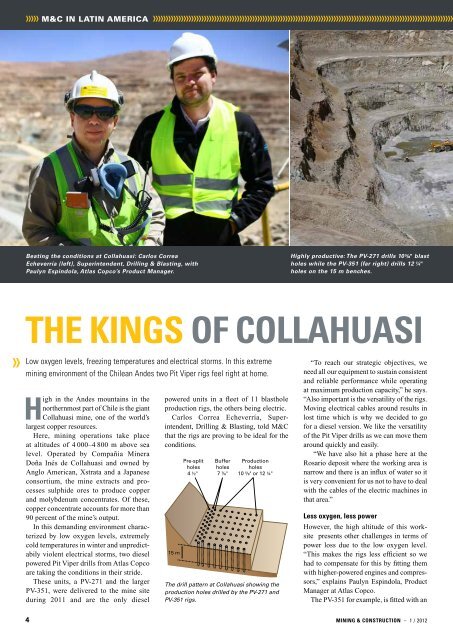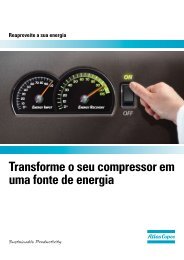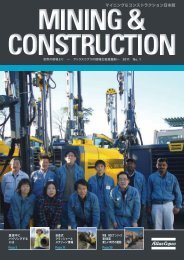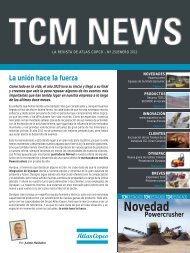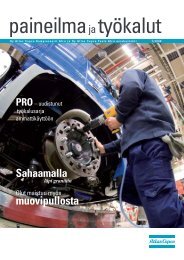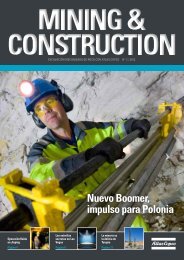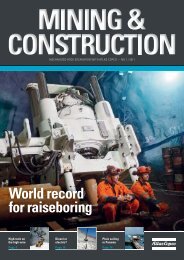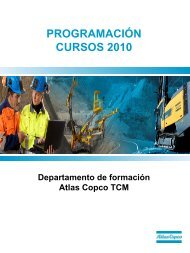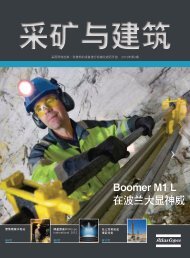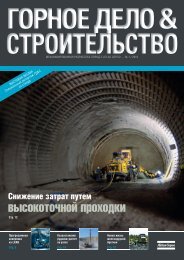Exploration drilling Serbian style - Atlas Copco
Exploration drilling Serbian style - Atlas Copco
Exploration drilling Serbian style - Atlas Copco
Create successful ePaper yourself
Turn your PDF publications into a flip-book with our unique Google optimized e-Paper software.
M&C in latin America >>>>>>>>>>>>>>>>>>>>>>>>>>>>>>>>>>>>>>>>>>>>>>>>>>>>>>>>>>>>>>>>>>>>>>>>>>>>>>>>>>>>>>>>>>>>>>>>>>>>>>>>>>>>>>>>>>>>>>><br />
Beating the conditions at Collahuasi: Carlos Correa<br />
Echeverría (left), Superintendent, Drilling & Blasting, with<br />
Paulyn Espindola, <strong>Atlas</strong> <strong>Copco</strong>’s Product Manager.<br />
Highly productive: The PV-271 drills 10 5/8" blast<br />
holes while the PV-351 (far right) drills 12 ¼"<br />
holes on the 15 m benches.<br />
The kings of Collahuasi<br />
Low oxygen levels, freezing temperatures and electrical storms. In this extreme<br />
mining environment of the Chilean Andes two Pit Viper rigs feel right at home.<br />
High in the Andes mountains in the<br />
northernmost part of Chile is the giant<br />
Collahuasi mine, one of the world’s<br />
largest copper resources.<br />
Here, mining operations take place<br />
at altitudes of 4 000–4 800 m above sea<br />
level. Operated by Compañia Minera<br />
Doña Inés de Collahuasi and owned by<br />
Anglo American, Xstrata and a Japanese<br />
consortium, the mine extracts and processes<br />
sulphide ores to produce copper<br />
and molybdenum concentrates. Of these,<br />
copper concentrate accounts for more than<br />
90 percent of the mine’s output.<br />
In this demanding environment characterized<br />
by low oxygen levels, extremely<br />
cold temperatures in winter and unpredictabily<br />
violent electrical storms, two diesel<br />
powered Pit Viper drills from <strong>Atlas</strong> <strong>Copco</strong><br />
are taking the conditions in their stride.<br />
These units, a PV-271 and the larger<br />
PV-351, were delivered to the mine site<br />
during 2011 and are the only diesel<br />
powered units in a fleet of 11 blasthole<br />
production rigs, the others being electric.<br />
Carlos Correa Echeverría, Superintendent,<br />
Drilling & Blasting, told M&C<br />
that the rigs are proving to be ideal for the<br />
conditions.<br />
15 m<br />
Pre-split<br />
holes<br />
4 ½"<br />
Buffer<br />
holes<br />
7 7/8"<br />
Production<br />
holes<br />
10 5/8" or 12 ¼"<br />
The drill pattern at Collahuasi showing the<br />
production holes drilled by the PV-271 and<br />
PV-351 rigs.<br />
“To reach our strategic objectives, we<br />
need all our equipment to sustain consistent<br />
and reliable performance while operating<br />
at maximum production capacity,” he says.<br />
“Also important is the versatility of the rigs.<br />
Moving electrical cables around results in<br />
lost time which is why we decided to go<br />
for a diesel version. We like the versatility<br />
of the Pit Viper drills as we can move them<br />
around quickly and easily.<br />
“We have also hit a phase here at the<br />
Rosario deposit where the working area is<br />
narrow and there is an influx of water so it<br />
is very convenient for us not to have to deal<br />
with the cables of the electric machines in<br />
that area.”<br />
Less oxygen, less power<br />
However, the high altitude of this worksite<br />
presents other challenges in terms of<br />
powe r loss due to the low oxygen level.<br />
“This makes the rigs less efficient so we<br />
had to compensate for this by fitting them<br />
with higher-powered engines and compressors,”<br />
explains Paulyn Espindola, Product<br />
Manage r at <strong>Atlas</strong> <strong>Copco</strong>.<br />
The PV-351 for example, is fitted with an<br />
4 Mining & Construction – 1 / 2012


